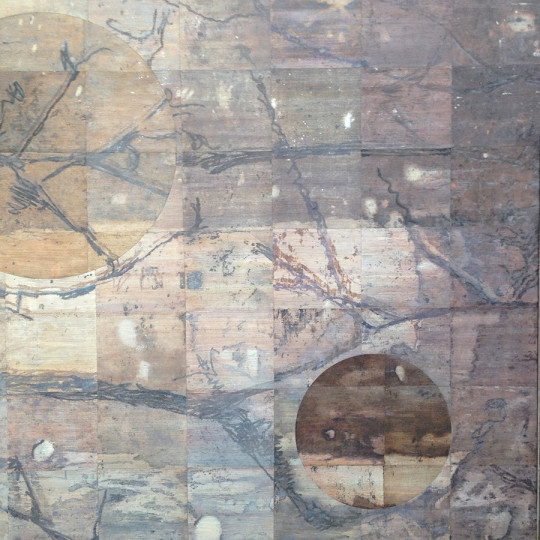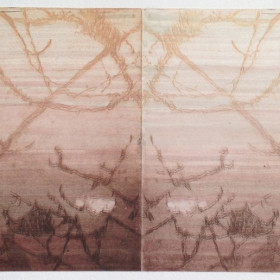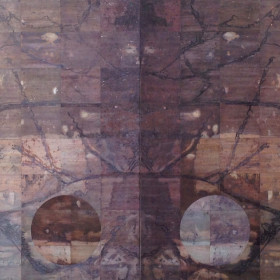
Gallery Elena Shchukina, 25 August – 16 September 2016
Bella Easton develops, replicates and reflects on apparently straightforward scenes from everyday life to generate a complex account of the multiple relationships and contradictions between inside and outside, natural and artificial, open and enclosed, chaos and order, uncanny and familiar, light and dark. In so doing, she takes her source material through a dizzying range of transformations to suggest the various selves that might be in play when we formulate our own identities.
Caterpillar: The question you need is Who Are You?
Aly: Tell him he can see perfectly well who you are
Alice: You can see perfectly well who I am.
Caterpillar: But that’s not true, is it? These outer shells are only versions of ourselves…[1]
Identical Twins, 2013, is an immersive landscape that has been fragmented into 48 smaller elements. That arises from Easton’s characteristic hybrid technique of painting and printmaking. Here she has etched copper plates, printing each onto a single piece of paper, the hand painted inky marks from which are then offset onto a second piece of paper by running it through the press again – so producing its mirror counterpart. She has repeated this many times incorporating watercolour and graphite powder. The Rorschach-like result is a coming-together that may look like one complete object or view, but is actually a doubling of two halves. Those halves are often noticeably different, due to glitches and variations in depth of tone, completeness of impression, or sharpness of registration. Easton accepts and even encourages those chance effects by using the same source repeatedly – ‘murdering the copper plates’, as she puts it, ‘till you can’t get any more from them’. Her method, she says, ‘is a kind of controlled spontaneity which generates abstract effects on the figurative ground. Each section has its own personality, so that when the family of panels are spliced together, harmonies and dissonances arise’. Identical Twins, a one-off by the very nature of how it’s made, acted as the source image for the ‘Chiral’ (meaning ‘hand’ in Greek) series of etchings, drawings and paintings.
Each of the Chiral etching series, 2014, selects a detailed sector for further development, notably by adding watercolour layers to give greater depth and illusion of light, and by cutting in some elements and swapping them over. Hence what look like double moons, which cannot be mapped when superimposed over each other – like opposite hands, they have ‘chiral symmetry’. ‘Creating’, says Easton, ‘is a journey of complementary opposites. I employ actions that are contradicted or opposed until equilibrium is reached’.
These etchings initiated larger works in which selected motifs are reconfigured into immersively-scaled fabrications using a geometric framework: Chiral I, 2014, and Chiral II, 2015, onto 128 and 50 oil painted linen panels; Chiral VI, 2015, in graphite and coloured pencil on 50 paper panels. The process, as shown in the filmed documentation of the progress of Chiral I, scales up and mirrors the minutiae to an almost perverse extent. Each section is individually rendered by applying thin layers of oil paint over a long period of time. These paintings don’t use etching, but relate directly to the etched works as weight, pressure and touch are similarly employed to offset the oil painted and hand drawn marks from one panel to its counterpart, so creating a mirror image. Chiral II adds a further layer of illusion and depth of light by including a synthesized lens flare as if from off kilter photographic documentation.
A further step then sees Easton come inside: not to the studio – in line with the expected artistic tradition – but into her house, which has a distinctive mixture of Edwardian original features, silkscreened wallpaper by the artist, and Japanese decorative papers used to cover furnishings and fittings. At first it seems that Easton has transported the house, as an autobiographical account of her decorative taste, into the gallery. The Myriorama Room Series – Fireplace, Armchair and Lamp (all 2016, each made from 88 copper plate etchings) give context to what now seem to be windows letting onto landscapes. Yet closer examination reveals that those objects are not so straightforward: each are chiral versions of the same 44 parts twice – so, for example, we see two sets of bellows in the fireplace – or rather, the same pair of bellows twice.
And while the individual units which make up the chiral forms are mosaic-like squares, the totality of the images combine in a different way. Look at how the skirting boards and picture rail line up: a continuity and interchangeability is implied. We could move the depicted furniture around the room and maintain that. This, consistent with the era of the house’s contents, is a version of the parlour game Myriorama, in which imaginary landscapes could be made by reordering cards designed to ensure matching continuity of the horizontal markers of form.
Is that all? No, the dialectic of inside-outside acquires another shift when we notice that there’s a mirror above the fireplace, and what we see in the mirror is Chiral VI. That hangs on the wall in Armchair, and Fireplace shows its reflection in a mirror – or, rather, half of that reflected image, doubled. Could the domestic intimacy get more fragmented, and the outside come in more complexly?
Through all these transformations, Easton’s work picks up an aesthetic of its own, one which destroys colour and completeness of form to arrive at a washed out process-contingent amalgam of parts. The established romantic appeal of ruins is in the background as the chiral play, near-repetition and range of imperfections is displaced at first glance by a frisson of beauty. That’s only the surface, of course – we shouldn’t need the caterpillar or the artist to remind us of that – but we also know how disturbingly easy it is to slip into equating shell with content, beauty with virtue, appearance with underlying reality.
Curation and text by Paul Carey-Kent




